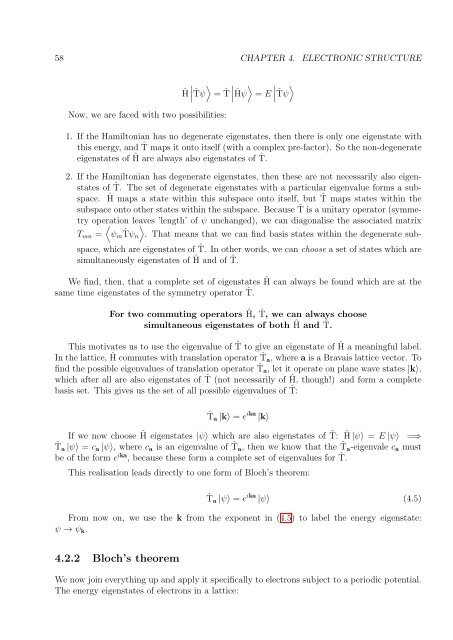Set of supplementary notes.
Set of supplementary notes.
Set of supplementary notes.
Create successful ePaper yourself
Turn your PDF publications into a flip-book with our unique Google optimized e-Paper software.
58 CHAPTER 4. ELECTRONIC STRUCTURE<br />
Now, we are faced with two possibilities:<br />
〉<br />
∣<br />
Ĥ ∣ˆTψ = ˆT<br />
〉 〉<br />
∣<br />
∣Ĥψ ∣<br />
= E ∣ˆTψ<br />
1. If the Hamiltonian has no degenerate eigenstates, then there is only one eigenstate with<br />
this energy, and ˆT maps it onto itself (with a complex pre-factor). So the non-degenerate<br />
eigenstates <strong>of</strong> Ĥ are always also eigenstates <strong>of</strong> ˆT.<br />
2. If the Hamiltonian has degenerate eigenstates, then these are not necessarily also eigenstates<br />
<strong>of</strong> ˆT. The set <strong>of</strong> degenerate eigenstates with a particular eigenvalue forms a subspace.<br />
Ĥ maps a state within this subspace onto itself, but ˆT maps states within the<br />
subspace onto other states within the subspace. Because ˆT is a unitary operator (symmetry<br />
operation leaves 〉 ’length’ <strong>of</strong> ψ unchanged), we can diagonalise the associated matrix<br />
T mn =<br />
〈ψ m ˆTψn . That means that we can find basis states within the degenerate subspace,<br />
which are eigenstates <strong>of</strong> ˆT. In other words, we can choose a set <strong>of</strong> states which are<br />
simultaneously eigenstates <strong>of</strong> Ĥ and <strong>of</strong> ˆT.<br />
We find, then, that a complete set <strong>of</strong> eigenstates<br />
same time eigenstates <strong>of</strong> the symmetry operator ˆT.<br />
Ĥ can always be found which are at the<br />
For two commuting operators Ĥ, ˆT, we can always choose<br />
simultaneous eigenstates <strong>of</strong> both Ĥ and ˆT.<br />
This motivates us to use the eigenvalue <strong>of</strong> ˆT to give an eigenstate <strong>of</strong> Ĥ a meaningful label.<br />
In the lattice, Ĥ commutes with translation operator ˆT a , where a is a Bravais lattice vector. To<br />
find the possible eigenvalues <strong>of</strong> translation operator ˆT a , let it operate on plane wave states |k〉,<br />
which after all are also eigenstates <strong>of</strong> ˆT (not necessarily <strong>of</strong> Ĥ, though!) and form a complete<br />
basis set. This gives us the set <strong>of</strong> all possible eigenvalues <strong>of</strong> ˆT:<br />
ˆT a |k〉 = e ika |k〉<br />
If we now choose Ĥ eigenstates |ψ〉 which are also eigenstates <strong>of</strong> ˆT: Ĥ |ψ〉 = E |ψ〉 =⇒<br />
ˆT a |ψ〉 = c a |ψ〉, where c a is an eigenvalue <strong>of</strong> ˆT a , then we know that the ˆT a -eigenvale c a must<br />
be <strong>of</strong> the form e ika , because these form a complete set <strong>of</strong> eigenvalues for ˆT.<br />
This realisation leads directly to one form <strong>of</strong> Bloch’s theorem:<br />
ˆT a |ψ〉 = e ika |ψ〉 (4.5)<br />
From now on, we use the k from the exponent in (4.5) to label the energy eigenstate:<br />
ψ → ψ k .<br />
4.2.2 Bloch’s theorem<br />
We now join everything up and apply it specifically to electrons subject to a periodic potential.<br />
The energy eigenstates <strong>of</strong> electrons in a lattice:








